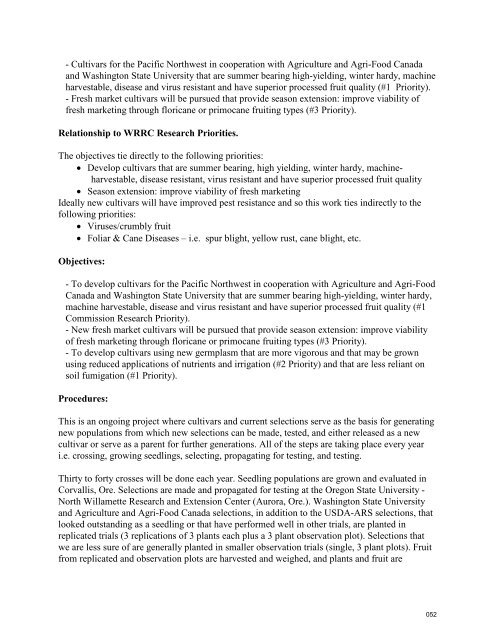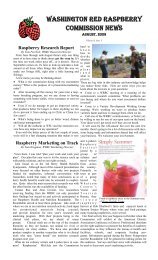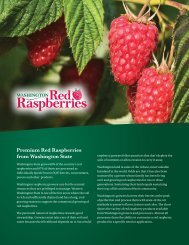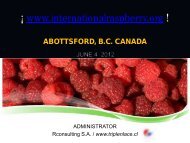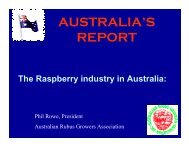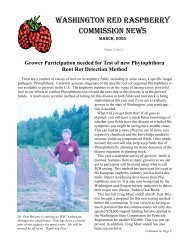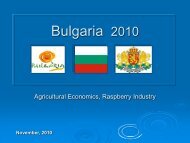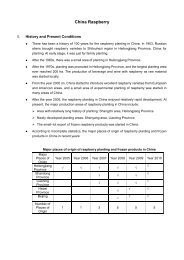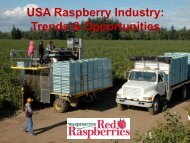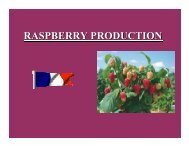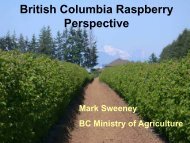2012 - Washington Red Raspberry Commission
2012 - Washington Red Raspberry Commission
2012 - Washington Red Raspberry Commission
Create successful ePaper yourself
Turn your PDF publications into a flip-book with our unique Google optimized e-Paper software.
- Cultivars for the Pacific Northwest in cooperation with Agriculture and Agri-Food Canada<br />
and <strong>Washington</strong> State University that are summer bearing high-yielding, winter hardy, machine<br />
harvestable, disease and virus resistant and have superior processed fruit quality (#1 Priority).<br />
- Fresh market cultivars will be pursued that provide season extension: improve viability of<br />
fresh marketing through floricane or primocane fruiting types (#3 Priority).<br />
Relationship to WRRC Research Priorities.<br />
The objectives tie directly to the following priorities:<br />
• Develop cultivars that are summer bearing, high yielding, winter hardy, machineharvestable,<br />
disease resistant, virus resistant and have superior processed fruit quality<br />
• Season extension: improve viability of fresh marketing<br />
Ideally new cultivars will have improved pest resistance and so this work ties indirectly to the<br />
following priorities:<br />
• Viruses/crumbly fruit<br />
• Foliar & Cane Diseases – i.e. spur blight, yellow rust, cane blight, etc.<br />
Objectives:<br />
- To develop cultivars for the Pacific Northwest in cooperation with Agriculture and Agri-Food<br />
Canada and <strong>Washington</strong> State University that are summer bearing high-yielding, winter hardy,<br />
machine harvestable, disease and virus resistant and have superior processed fruit quality (#1<br />
<strong>Commission</strong> Research Priority).<br />
- New fresh market cultivars will be pursued that provide season extension: improve viability<br />
of fresh marketing through floricane or primocane fruiting types (#3 Priority).<br />
- To develop cultivars using new germplasm that are more vigorous and that may be grown<br />
using reduced applications of nutrients and irrigation (#2 Priority) and that are less reliant on<br />
soil fumigation (#1 Priority).<br />
Procedures:<br />
This is an ongoing project where cultivars and current selections serve as the basis for generating<br />
new populations from which new selections can be made, tested, and either released as a new<br />
cultivar or serve as a parent for further generations. All of the steps are taking place every year<br />
i.e. crossing, growing seedlings, selecting, propagating for testing, and testing.<br />
Thirty to forty crosses will be done each year. Seedling populations are grown and evaluated in<br />
Corvallis, Ore. Selections are made and propagated for testing at the Oregon State University -<br />
North Willamette Research and Extension Center (Aurora, Ore.). <strong>Washington</strong> State University<br />
and Agriculture and Agri-Food Canada selections, in addition to the USDA-ARS selections, that<br />
looked outstanding as a seedling or that have performed well in other trials, are planted in<br />
replicated trials (3 replications of 3 plants each plus a 3 plant observation plot). Selections that<br />
we are less sure of are generally planted in smaller observation trials (single, 3 plant plots). Fruit<br />
from replicated and observation plots are harvested and weighed, and plants and fruit are<br />
052


